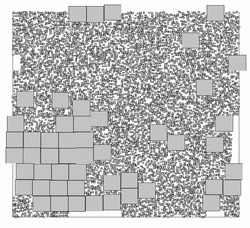Spheres That Won’t Mix

The question is simple to state but difficult to answer: Would a mixture of basketballs and ping-pong balls filling the Mir space craft remain mixed or eventually separate? A system of large and small spheres is a crude model of a colloid, where larger molecules or particles are suspended in a liquid of smaller molecules, such as water. Researchers have hotly debated the question, as computer simulations have given ambiguous results, but in the 27 April issue of PRL a team in France shows with a new algorithm that the system clearly separates.

The problem assumes the particles (which could be cubes, or any other shape) can bounce off of one another but otherwise don’t interact, so the only cause for separation is entropy–the system ultimately seeks the most probable state, the one with the largest number of configurations. When two large particles approach so closely that they exclude small ones, a pressure difference of the small particles builds up, pulling the large ones closer together. This “depletion force” is easy to understand and simulate as a short-range effect which favors phase separation, or “demixing,” but traditional Monte Carlo simulations have had difficulty detecting longer-range effects. The trouble is that, with particles of very different sizes and at high volume densities, the large particles are practically boxed-in, like the Pope surrounded by an admiring crowd. So it takes very long Monte Carlo runs to simulate significant motion and see the long-term effects.
For their PRL paper, Werner Krauth and Arnaud Buhot, of the Ecole Normale Supérieure in Paris, used an algorithm that generates long-distance motion of the large particles, while respecting “detailed balance,” a fundamental principle of thermodynamics. To understand a two-dimensional version of their algorithm, imagine a number of randomly placed coins on a tabletop. If you trace the coins’ positions on transparent plastic and rotate it 180 degrees about a randomly chosen point, some “copies” will overlap with some “originals,” forming groups called “clusters,” which do not overlap. Now choose a subset of the clusters in which to exchange copies for originals, and start the process again with the new set of originals. (This figure helps to explain the algorithm originally proposed by Krauth and Dress.)
The algorithm breaks down when the system is so densely packed that it forms one large cluster, but Krauth and Buhot report that this “percolation threshold” is independent of the size ratio of the particles, allowing them to explore the previously inaccessible large-ratio regime. This is also the most important limit for applications to colloids and the one where Monte Carlo methods have had difficulty.
Using their algorithm, Krauth and Buhot found a clear phase separation using both spheres and cubes. They included particles in their simulations, while others had difficulty running Monte Carlo simulations with only about “It’s a major advance in the field,” says Dominique Levesque, of the Université de Paris-Sud in Orsay, France. He agrees with the authors that it is the clearest demonstration yet of phase separation in this system.


